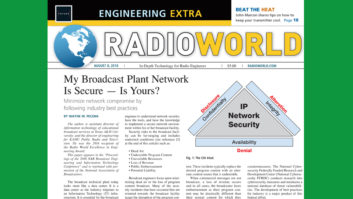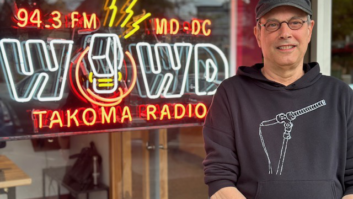In this and the previous three issues of Radio World Engineering Extra, we have featured a series of articles by Buc Fitch on small power generation — the ins, outs and gotchas of using small, portable generators for emergency power supply at broadcast facilities. This topic has been timely. We all deal with power outages and issues, and not all stations can afford a permanently-installed standby generator. We do what we must to get by and stay on the air.
It seems to me that commercial power has become less reliable than it has been in years past. The electric utilities do a lot of things right — “smart meters” that allow remote monitoring have been a game changer — but there are some problems, too.
If you live and work in a fairly new suburban area as I do, you’re probably in pretty good shape. Chances are the electric grid in your area was built in recent years, and it’s also likely that most of the grid, at least at the distribution level, is underground and not exposed to the elements. That does a lot for reliability.
If, however, you’re in an older area, most likely you’re being fed from an old power grid with components that may be 60+ years old. Sometimes this is fairly easy to see. The distribution grid is likely overhead, with insulators, transformers and (sometimes cloth-insulated) wire plainly visible. And for a lot of reasons, facilities being fed from old infrastructure are prone to more outages, particularly during inclement weather.
According to a recent report from the American Society of Civil Engineers, most electric transmission and distribution lines were constructed in the 1950s and 1960s with a projected 50-year lifespan. You can do the math. We are well beyond that projected lifespan, and it’s fairly rare to see a utility doing wholesale upgrades. So, we live with old infrastructure on which repairs are made only on demand.
WORKAROUNDS
As I think about the electric infrastructure at the sites around my company, I realize that we have had to put some extraordinary workarounds in place.
A good example is one of our Chicago transmitter sites, which is on the east side and very near the Indiana state line. This site is located in what used to be a heavy industrial area with steel mills and factories all coming off the same feeder. Those heavy industries were all boarded up or torn down decades ago, leaving our site as the only customer at the end of a very long feeder.
That feeder runs through a forest preserve into which it is very difficult to get trucks and equipment for line maintenance. Many of the spreaders are broken, and in some places, pieces of the spreaders are hanging from the wire.
When a big wind comes up, it’s not uncommon for the phase wires to get together and momentarily short. If we’re lucky, the short clears itself without blowing the upstream fuse, but many times we’re still left with brief phase outages, usually less than a second but sufficient to take the station down momentarily.
I remember taking the GM out to the site one time to show him what was happening — I think he believed there was an equipment problem on our end, but he soon found out the truth. As he and I were standing in the building, the lights would flicker and the transmitter would cycle off and back on. It happened several times in the ten minutes we were standing there.
The electric utility was aware of the issue, but either didn’t have budget or sufficient justification to go through that forest preserve span and replace spreaders, insulators and poles. Remember that our site was the only customer on the span, and the span was several miles long. One customer, even one that spends several thousand dollars per month in utility costs, evidently doesn’t justify spending several hundred thousand dollars to upgrade the infrastructure.
At the time, the transmitter had a tube-type PA and a phase loss monitor, and if the phase was lost for more than a few hundred milliseconds, the filament would power down and the plate circuit would be locked off until the time-out timer had finished its count. That meant a minute or more off the air, an eternity in a very competitive PPM market. Obviously, we could not live with this. So, what did we do?
We already had a generator at the site, but these outages were so short that it never came into play unless we deliberately put it online — which we did when the wind would get up. But that was not a long-term plan, and it was expensive in terms of fuel and maintenance. We quite literally wore out our generator.
It was at that point that we began looking at UPS options, and we found and settled on a flywheel UPS from Active Power. We had to upgrade the electric service and our own infrastructure to use the flywheel UPS — it was a 480-volt 150 kVA unit, and our site was 208 volts. We got the utility to set a new pad-mounted 150 kVA 480-volt transformer, and we replaced our tired 208-volt 70 kW generator with a new 480-volt 150 kW unit, including 480-volt transfer switch.

The UPS came in its own building, complete with dual, dedicated HVAC units, and we set it on its own pad. It also had bypass switches so we could remove it from the circuit for maintenance. It had capacity to fully power the site for 40 seconds with no utility power, plenty of time for a generator startup cycle, but we needed it more for riding through those brief glitches.
The effect was immediate and glaringly evident: no more power glitches and no more signal interruptions. The UPS itself tracks all the hits and brown-outs, and we can monitor them via the user interface. While I can’t remember what the figure was, it was stunning. We were getting a lot more power hits at that site than we were aware of.
That UPS continues to buffer power the site 14 years later. Maintenance is fairly simple, but a little expensive. We have to replace the oil in the vacuum pump annually (easy and cheap — the flywheel operates in a vacuum inside a sealed chamber so that it has no air resistance). The big expense is the bi-annual replacement of the flywheel bearings, which is a fairly big number and an all-night job. Still, it’s well worth it.
LEGWORK
Perhaps that is an extreme example of the issue of an aging infrastructure, but it illustrates the kind of thing that broadcasters sometimes have to do to compensate. It’s likely that in most cases, if the problem area can be identified, the local utility will fix it, but you may have to do at least some of the legwork yourself.
An interesting example of this was also in Chicago some years back. A phase fuse on the 7.5 kV feed to a site would blow, sometimes daily, and at about the same time. We thought it might be some utility switchgear causing the problem, but the times didn’t line up with the switchgear operation.
Some sleuthing revealed the source of the problem. The feeder ran alongside a rail yard, one in which grain hoppers were switched in and out. When the cars would bang together and couple, some grain would spill. The local pigeon population figured this out, and they would sit on the phase wires waiting.
When the cars would couple and the grain would fall, they would all take flight, each one trying to be the first to get to the spilled grain, and … well, let’s just say that the birds’ feet still on the phase wires without the birds was a clue, as were the footless bird carcasses below. The utility replaced the spreaders in that area with longer ones so that the pigeons’ wings would not touch those of other birds when they took flight. Problem solved.
Those are just two anecdotes of many that I have accumulated over the years. What I can tell you is that grid isn’t getting any younger, and utilities are not, as a rule, upgrading it except in areas of new development.
The elevated RF noise floor in some areas is clear evidence of a failing infrastructure — corona is often present in places with cracked or broken insulators or sharp projections, and the broadband RF noise is propagated by the wires, which make excellent antennas. This costs the utility company power, but it’s cheaper to live with it than expend the effort, money and manpower to track it down and fix it.
So … this often leaves it up to us, the broadcast engineers, to sleuth out the problems and pester the utility companies to fix them. It’s often not easy, but the squeaky wheel gets the grease. Persistence pays off, and the payoff is cleaner, more reliable power, which translates to a more reliable on-air signal, and that keeps the boss happy.
Cris Alexander, CPBE AMD DRB, is director of engineering of Crawford Broadcasting Co. and technical editor of RW Engineering Extra.












